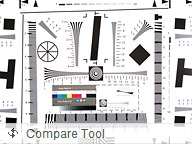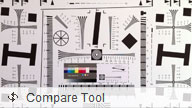Samsung Galaxy S III US edition review: Blockbuster
Blockbuster
8 MP camera is great
The Samsung Galaxy S III offers the same camera resolution but actually improves on the performance. It can capture stills of up to 3264 x 2448 pixels and 1.9 MP ones with the front-facing cam.
The latest Galaxy offers geotagging, touch focus, face and smile detection and digital image stabilization. Due to the fast dual-core processor it is also able to simultaneously record HD (1080p or 720p) video and take near full-resolution pictures (those are cropped to an aspect ratio of 16:9 to match that of the videos and what is shown in the viewfinder).
The camera interface is quite similar to what the Galaxy S II has. You get two shortcut bars on each side of the viewfinder - on the right you get the still camera / camcorder switch, a virtual shutter key and the gallery shortcut (which is a thumbnail of the last photo taken).
On the left you get several controls and the good news is that you can pick any four shortcuts to put there - you can easily have all frequently used features just a tap away. The fifth shortcut always points to Settings.






Samsung Galaxy S III camera UI
The Galaxy S III's camera has an F/2.6 aperture as opposed to the F/2.65 of its predecessor and focal length of 3.7 mm compared to the 3.97 mm of the Galaxy S II. This results in slightly wider field of view on the Galaxy S III.
Samsung were bragging left and right about the zero shutter lag of the Galaxy S III and we are happy to report that the smartphone is able to deliver. Pictures are snapped extremely fast and there's even a burst mode available where you hold the virtual on-screen shutter and the phone will make 20 consecutive shots in just 6 seconds or so.
The good thing is that the images, produced in burst mode are in full 8 MP resolution. We were told that the S III is actually capable of capturing full res shots at 3.3fps for much longer than that, but the 20 shot limit was set to prevent users from filling their storage with hundreds of identical shots.
There's an option called Best photo available in Burst shot mode - it snaps 8 photos in a row and lets the phone automatically pick the best one (where people are smiling and aren't blinking). There's also HDR mode for high-contrast scenes.
Photos from the Samsung Galaxy S III are sharp and with very low levels of noise and plenty of detail. Color reproduction is okay, though greens seem slightly more saturated than reds and blues. The dynamic range is very good too, thus adding up to what is certainly one of the best 8MP shooters around.












Samsung Galaxy S III camera samples
Photo quality comparison
The Samsung Galaxy S III joins the 8MP gang in our Photo Compare Tool. The first chart shows better sharpness over the S II - it's especially noticeable in the small numbers below the color patches. Speaking of colors, the second chart shows a pretty clean separation between each color square, though there is some oversharpening halo visible on some edges.
The Galaxy S III does a better job at finding the right white balance than its predecessor, even indoors under artificial lighting. The fine detail in the chart also pegs the Galaxy S III camera as one of the sharpest around.



Samsung Galaxy S III in our Photo Compare Tool
Video recording is top notch
The Samsung Galaxy S III is able to record FullHD 1080p and HD 720p video hassle-free. During recording you can also snap full-res 16:9 stills.
The camcorder interface is almost the same as the still camera's - you get the same customizable panel on the left for up to five shortcuts.




Samsung Galaxy S III camcorder UI
The 1080p videos are impressively smooth, noise-free and with plenty of detail and good colors. The video container used is mp4 and it creates clips with a bitrate of about 17-18Mbps, which is enough to encode the video with no traces of compression. The framerate stays pretty solid at 30fps.
The same goes for the 720p videos, which have an average bitrate of 12Mpbs. Unlike the S II, the Galaxy S III camera has the same field of view whether you're recording 1080p or 720p videos.
Both 1080p and 720p videos are recorded with stereo sound using the AAC codec with a bitrate of 134Kbps and sampling rate of 48kHz.
Here are a couple of video samples we uploaded to YouTube. Don't forget to choose 1080p and 720p respectively and watch them in fullscreen.
We've prepared an untouched 1080p@30fps video clip from the Galaxy S III for you to download.
The front-facing camera can take 720p videos too.
Video quality comparison
The Video Quality Compare tool is where you can observe how each of the contenders handles changes in lighting, what actual resolution they achieve in FullHD recording and what levels of detail are produced.



Samsung Galaxy S III in the Video Compare Tool
The Galaxy S II used to be pretty good, but the S III is noticeably better - in good light, even the small type in the banner on our Ferris wheel remains sharp and legible. Still, the fine texture on the fake blue sky isn't as noticeable as it is in, say, iPhone 4S videos.
The Samsung Galaxy S III produces very usable videos with very little noise even when the light isn't favorable. Finally, the synthetic resolution chart also gives the thumbs up to the S III.
Reader comments
- Anonymous
- 17 Jul 2021
- 64i
Too bad you can't think logically. Liberalism has rotted your cognitive brain function.
- AnonD-414528
- 08 Jul 2015
- Nw8
I am using Samsung galaxy slll and my network doesn't come as HSDPA
- rinku
- 25 Mar 2015
- rA%
Can I unlock my S3 SGH I747 and use in India as I am in India for more than 6 months from now & pls suggest a genuine unlocking process